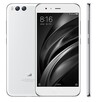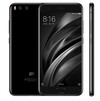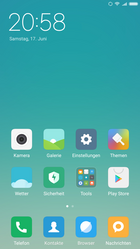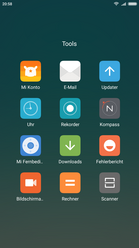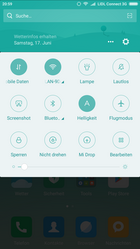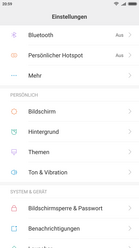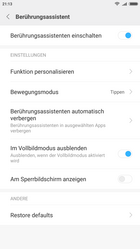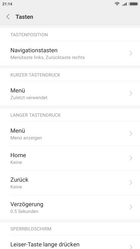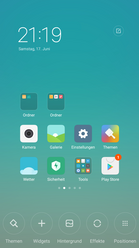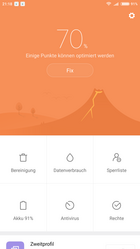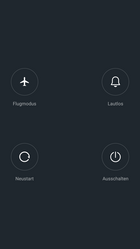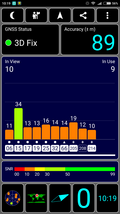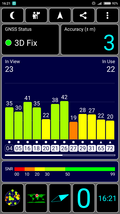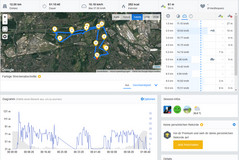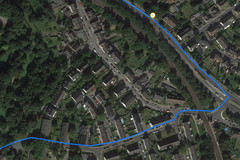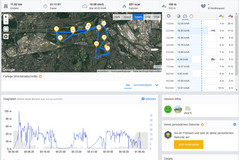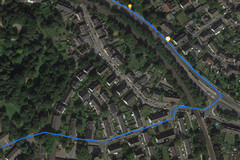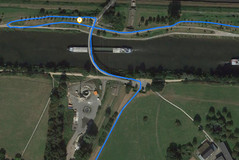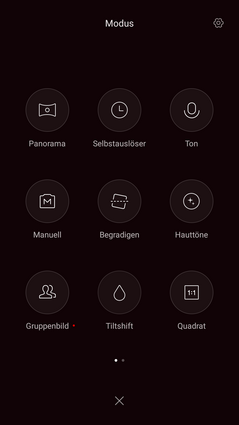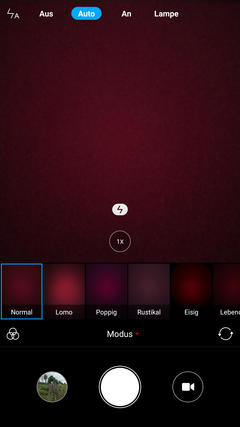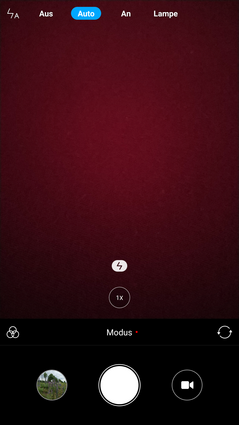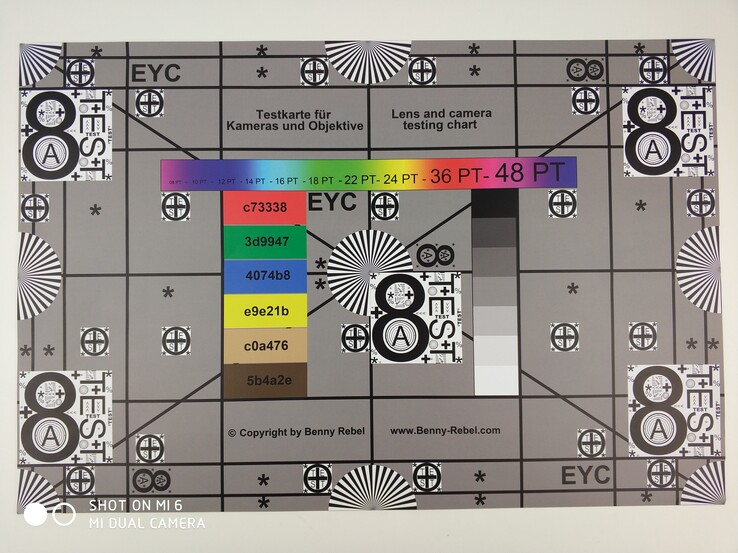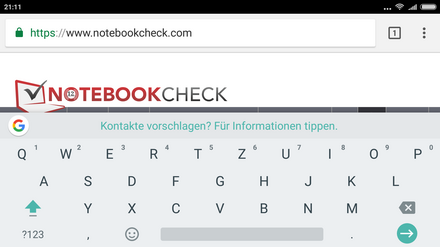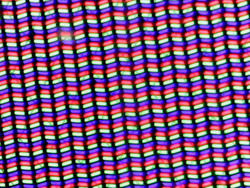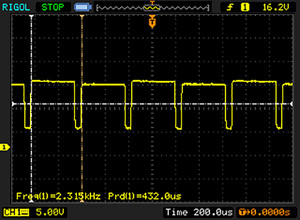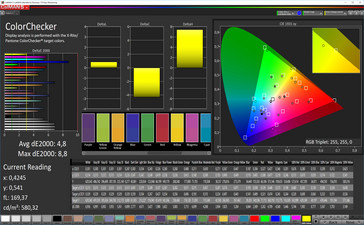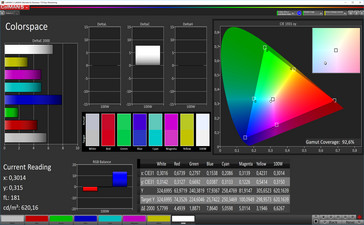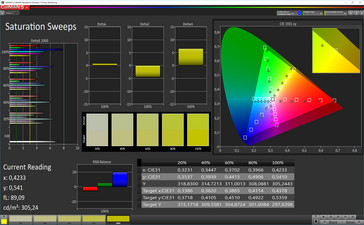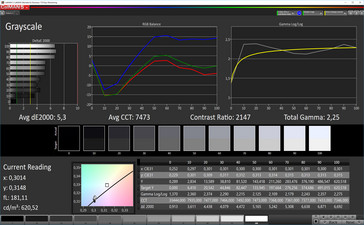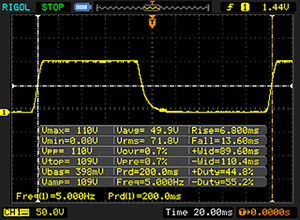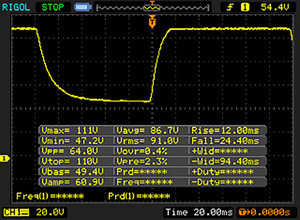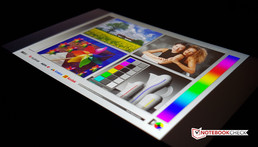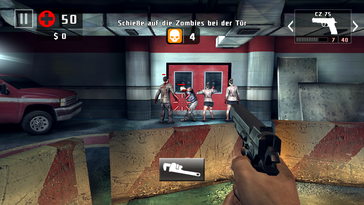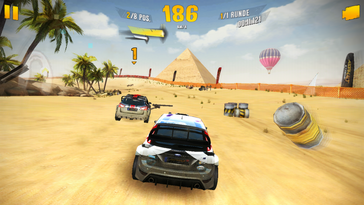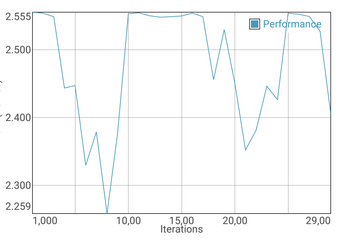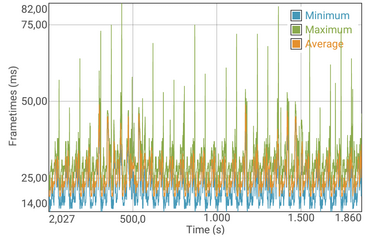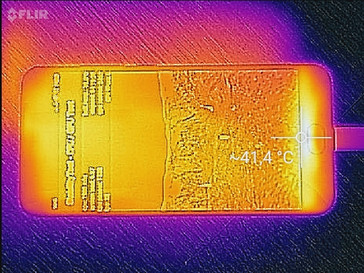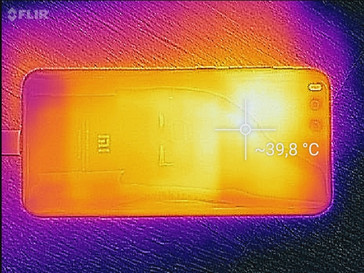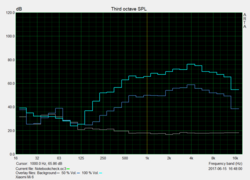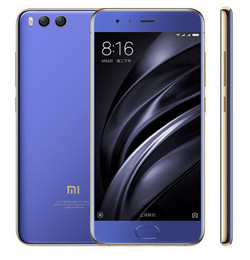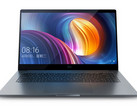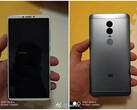Xiaomi Mi6 Smartphone Review
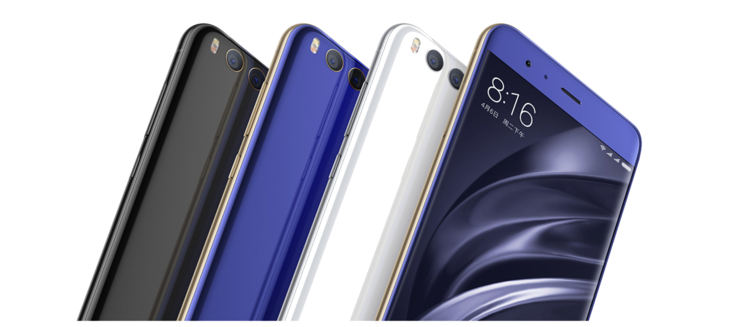
For the original German review, see here.
As expected, the Chinese manufacturer Xiaomi have also updated their Mi series this year, presenting the sixth Test Xiaomi Mi6 Smartphone generation of their in-house high-end series. The biggest changes of this year's product update have been under the hood, since the outside appearance has changed very little compared to the Mi5 and Mi5s.
As with its predecessor, the Xiaomi Mi6 has a 5.15-inch IPS LCD panel with a resolution of 1920x1080 pixels. To supply the power, a 3350-mAh battery is built-in, which gives us hope for a very good battery life considering the display size. Inside the dual-SIM smartphone a Snapdragon 835, which is currently the most powerful processor by Qualcomm, provides the necessary performance. Furthermore, there are 6 GB of RAM and up to 128 GB of UFS-2.1 memory.
For the first time, Xiaomi has built a dual camera system into one of their flagship devices. It consists of two 12-Megapixel cameras. The second camera module on the back of the device collects depth information which provides the photos with the so-called Bokeh effect. Moreover, the Mi6 is Xiaomi's first smartphone that is protected against water splashes.
The manufacturer's top model has 128 GB of internal storage and a ceramic back (~ 520 Euros/ ~$582; it currently costs around $600 in the US). For our test, we were provided with the variant of the Xiaomi Mi6 with 64 GB and a glass back (~ 400 Euros/ ~$450; starting at $440 in the US). The glass model is also available with a 128 GB of memory for an extra charge of about 70 Euros (~$78). There is no direct distribution planned for the European market, so that the Mi6 can only be purchased from importing vendors.
Possible competitors of the Xiaomi high-end smartphone and comparison devices in our test are the current smartphone elite of the Honor 8 Pro, the Samsung Galaxy S8, the LG G6, and the Huawei P10. Added are other representatives of the high-end such as the OnePlus 3T and the HTC U Ultra, which are available for similar prices.
Case
The Xiaomi Mi6 is available in three different color variants, black, blue and silver, and a black ceramic version with golden adornments around the camera lens. Not only has the screen diagonal of the Mi6 remained the same compared to the predecessor, but all the dimensions of the device are almost identical. The curved edges and slim form of merely 8 mm (~0.31 in) thickness make the Xiaomi device fit in the hand very well. Compared with the predecessor, the case appears even more ergonomic and of higher quality. The high weight of 168 g (5.9 oz) – the ceramic version is even 14 grams (0.49 oz) heavier is rather surprising for such a compact device. The edges around the IPS display are a little large for our tastes. At barely 72%, the Mi6 has a considerably more inefficient display-surface ratio than the 2017 high-end competition, the LG G6 or the Samsung Galaxy S8.
The keys for the volume adjustment and on/off on the right side of the case are easy to reach and have a comfortable pressure point. However, the keys are not sitting as tightly in the case as in a Samsung Galaxy S8 or the HTC U Ultra. Like Samsung, Xiaomi has also omitted a home button in these years. Instead, there is a capacitive sensor positioned in the center.
Features
The internal UFS-2.1 storage of our test unit has a capacity of 64 GB, with only 51.6 GB remaining for the user at the time of delivery. The storage of the dual-SIM smartphone cannot be extended.
The 3350 mAh battery is charged via USB 3.0 Type-C port at the bottom of the device. With an OTG adapter, peripheral devices such as external keyboards or USB sticks can be connected to the USB port. Headphones can also be connected via the USB port - you will look in vain for a 3.5-mm audio port in the Mi6.
The other features of the Mi6 include a fingerprint sensor, stereo speakers, Wi-Fi Direct, an infrared sensor, a compass, and a status LED. The wireless transfer of the display contents to an external monitor via Miracast is also supported and worked well in our test with an Android TV by Sony.
Software
In terms of system software, Xiaomi uses the MiUI operating system version 8.3, which is based on the current Google Android version 7.1. Since the Xiaomi-Mi devices are really only designed for the Chinese market, the in-house MiUI software does not really support Google services such as the Play Store or Google apps such as Gmail as it comes from the factory. Instead, Chinese services and Xiaomi's own services are used. However, there is a global version (Beta) which supports Google services and as well as Chinese and English, other languages (such as German) are available as the system language.
The user interface of the operating system is hardly reminiscent of stock Android. Even in its 8th version, MiUI is very colorful, which feels a little overloaded, but offers a lot of adjustment settings. The installed apps are not collected in an App Drawer, but spread over the various home screens. The design can be changed by the user to suite their individual tastes through the in-house Theme Store.
During our testing period - we used the global version (Beta 7.5.18) on our Mi6 – there were interruptions in the WLAN and some Google app crashes, particularly Gmail.
Communication and GPS
The integrated WLAN module masters the IEEE-802.11 standard according to a/b/g/n/ac. In addition, the Mi6 knows the 2x2-MIMO technology, enabling very high transfer rates. The transfer speeds that we measured between the smartphone and our Linksys EA 8500 reference router can be called excellent at 574 MBit/s (iperf server) and 500 MBit/s (iperf client). In everyday usage, the reception is also good and the WLAN signal is mostly stable, apart from some occasional drops. In close proximity to the router (Telekom Speedport, W921V) we measured a very low damping of -28 dBm.
The Xiaomi Mi6 supports using up to two Nano-SIM cards simultaneously. The Gigabit-LTE smartphone accesses the mobile Internet at up to 1 GB/s during downloads - this goes for both SIM card slots. However, the frequency coverage is not optimal, particularly in rural areas in Germany since the LTE band 20 is not supported. To our question, TradingShenzhen who provided our test unit responded that a global version of the Mi6 that would also cover the 800 MHz frequencies was not planned.
For wireless near-field communication, the user has an NFC chip as well as the most current version 5.0 of Bluetooth. However, the latter can only be used to the full extent with the Android O update.
| Networking | |
| iperf3 transmit AX12 | |
| Samsung Galaxy S8 | |
| Xiaomi Mi 6 | |
| Huawei P10 | |
| OnePlus 3T | |
| HTC U Ultra | |
| Honor 8 Pro | |
| LG G6 | |
| iperf3 receive AX12 | |
| Xiaomi Mi 6 | |
| Samsung Galaxy S8 | |
| LG G6 | |
| Huawei P10 | |
| OnePlus 3T | |
| HTC U Ultra | |
| Honor 8 Pro | |
To locate the position, the Mi6 uses the global GPS, GLONASS, and BeiDou satellite navigation systems. The position can even be located indoors with the high-end smartphone, however it is not very accurate. Outdoors, the results are much better and also much faster. To evaluate the accuracy of the location capabilities of our test device in practice, we record a route with Garmin Edge 500 GPS bicycle computer and our smartphone in parallel for comparison. In our GPS test, the Mi6 deviates by a mere 70 meters from the professional GPS device, although we can see some small inaccuracies as in the bridge area. Based on the measured data, we can infer an excellent accuracy in daily use.
Telephone and Call Quality
The voice reproduction and the sound and call quality of the ear speaker are quite satisfactory. The maximum volume achieved ensures that the conversation partner can be understood easily. The sound quality of the built-in microphone has also been reported by our conversation partner as clear and easily understandable.
Cameras
The main camera in the back of the Mi6 has a Sony Exmor RS sensor with a resolution of 12 MP in the 4:3 format (3968x2976 pixels). The IMX386 CMOS image sensor of the Japanese manufacturer has pixels that measure 1.25 μm edge to edge. The camera module has a focal distance of 27 mm (~1.1 in), an aperture of f/1.8, and a 4-axis OIS for image stabilization. The second camera on the back also has a resolution of 12 MP. However, the Samsung S5K3M3 image sensor has only an f/2.6 aperture and 1.0-µm pixel edge size. The 12-MP camera records videos in a 4K maximum resolution at 30 FPS. In addition slow-motion recordings are possible at 120 FPS in 720p.
As with the Apple iPhone 7 Plus, the Xiaomi Mi6 offers a two-times optical zoom and a dual-camera mode with Bokeh effects for pictures. In bright lighting conditions, the two camera modules ensure very sharp pictures rich in detail. However, the dynamic range is considerably smaller than in the LG G6. Moreover, the recorded colors appear slightly pale, and bright areas are slightly overexposed. Compared to the predecessor, the Mi6 can take very decent photos in daylight, though.
Despite the wide aperture of f/1.8, the Mi6 cannot really convince under dark light conditions. Even through the absolute brightness in the pictures is sufficient, the sharpness is not optimal, and a strong image noise dominates the pictures.
The Sony IMX268 image sensor of the front camera has a resolution of 8 MP. The 80-degree wide angle selfies can score with a good quality if sufficient light is available. Unfortunately, the module lacks an auto-focus for optimal image sharpness. The front camera records videos in Full HD resolution (1920x1080 pixels) at up to 30 images per second.
Accessories and Warranty
Besides the test unit, the box contains quick-start instructions, a modular charger, and a USB charging cable. In addition, Xiaomi includes a transparent plastic protective case with the Mi6. Earphones are not included.
Furthermore, TradingShenzhen added an EU adapter for the outlets used here; however, this is not part of the standard delivery but an additional service by the provider.
Xiaomi offers a global warranty of 12 months for their smartphones. Please see our Guarantees, Return policies and Warranties FAQ for country-specific information.
Input Devices and Operation
The capacitive multi-touchscreen reacts quickly and reliably up to the display edges. Moreover, the Corning Gorilla-4 glass surface has very good gliding characteristics. In terms of reliability and reaction time, there is nothing to complain.
Navigation is done with two illuminated capacitive keys below the display and a touch sensitive home button that has an integrated active fingerprint scanner. Its recognition rate is good, but often the finger has to be placed again on the sensor in order to be recognized. Overall the sensor reacts similarly fast and reliably as in Samsung's Galaxy-S models.
Display
As already in the Mi5, the IPS display of the Mi6 offers a Full HD resolution of 1920x1080 pixels in a 5.15-inch diagonal. This leads to a 428 PPI pixel density. Whether in a 2017 high-end smartphone with this display size, a WQHD-resolution (2560x1440 pixels) is necessary, is a matter of taste. In our opinion, the contents are displayed sufficiently sharp.
At a maximum of 620 cd/m², the panel brightness is very high. Furthermore, it is illuminated very evenly at 89%. However, the full illumination of the Mi6 (625 cd/m²) is only available when the surrounding light sensor is activated. In our APL50 measurement, which is closer to reality and simulates an even distribution of bright and dark areas on the IPS panel, it is still 598 cd/m².
At a very low brightness level, from 20% on we could measure screen flickering in a quite high frequency of 2315 Hz.
| |||||||||||||||||||||||||
Brightness Distribution: 89 %
Center on Battery: 620 cd/m²
Contrast: 2214:1 (Black: 0.28 cd/m²)
ΔE ColorChecker Calman: 4.8 | ∀{0.5-29.43 Ø4.77}
ΔE Greyscale Calman: 5.3 | ∀{0.09-98 Ø5}
Gamma: 2.25
CCT: 7473 K
| Xiaomi Mi 6 IPS, 1920x1080, 5.2" | Xiaomi Mi 5 IPS, 1920x1080, 5.2" | LG G6 IPS LCD, 2880x1440, 5.7" | Samsung Galaxy S8 Super AMOLED, 2960x1440, 5.8" | HTC U Ultra SLCD 5, 2560x1440, 5.7" | Huawei P10 LTPS, 1920x1080, 5.1" | Honor 8 Pro IPS, 2560x1440, 5.7" | OnePlus 3T Optic-AMOLED, 1920x1080, 5.5" | |
|---|---|---|---|---|---|---|---|---|
| Screen | -5% | 7% | 20% | -16% | -13% | 3% | -36% | |
| Brightness middle (cd/m²) | 620 | 598 -4% | 646 4% | 566 -9% | 470 -24% | 547 -12% | 541 -13% | 421 -32% |
| Brightness (cd/m²) | 586 | 566 -3% | 611 4% | 564 -4% | 445 -24% | 556 -5% | 514 -12% | 430 -27% |
| Brightness Distribution (%) | 89 | 90 1% | 89 0% | 94 6% | 88 -1% | 86 -3% | 91 2% | 84 -6% |
| Black Level * (cd/m²) | 0.28 | 0.51 -82% | 0.23 18% | 0.22 21% | 0.43 -54% | 0.3 -7% | ||
| Contrast (:1) | 2214 | 1173 -47% | 2809 27% | 2136 -4% | 1272 -43% | 1803 -19% | ||
| Colorchecker dE 2000 * | 4.8 | 3.5 27% | 4.5 6% | 2.7 44% | 5.5 -15% | 4.8 -0% | 3.2 33% | 7.1 -48% |
| Colorchecker dE 2000 max. * | 8.8 | 6.1 31% | 8.3 6% | 5.4 39% | 11.9 -35% | 8.8 -0% | 7.2 18% | 15.3 -74% |
| Greyscale dE 2000 * | 5.3 | 3.5 34% | 6 -13% | 3.1 42% | 7.6 -43% | 4.5 15% | 4 25% | 6.8 -28% |
| Gamma | 2.25 98% | 2.29 96% | 2.27 97% | 2.15 102% | 2.2 100% | 2.39 92% | 2.27 97% | 2.23 99% |
| CCT | 7473 87% | 6532 100% | 7996 81% | 6335 103% | 7454 87% | 7194 90% | 7120 91% | 7866 83% |
| Color Space (Percent of AdobeRGB 1998) (%) | 67.74 | 81.57 | ||||||
| Color Space (Percent of sRGB) (%) | 99.05 | 99.87 |
* ... smaller is better
Screen Flickering / PWM (Pulse-Width Modulation)
| Screen flickering / PWM detected | 2315 Hz | ≤ 20 % brightness setting | |
The display backlight flickers at 2315 Hz (worst case, e.g., utilizing PWM) Flickering detected at a brightness setting of 20 % and below. There should be no flickering or PWM above this brightness setting. The frequency of 2315 Hz is quite high, so most users sensitive to PWM should not notice any flickering. In comparison: 53 % of all tested devices do not use PWM to dim the display. If PWM was detected, an average of 8086 (minimum: 5 - maximum: 343500) Hz was measured. | |||
The combination of display brightness and a black value of 0.28 cd/m² results in an excellent contrast ratio of 1:2214. However, our APL-50 measurements reduce the high contrast, since the black value in evenly distributed bright and dark areas increases to 0.48 cd/m² (contrast 1:1246).
The display analysis with a photo spectrometer and the CalMAN software shows quite high deviations of the color (4.8) and grayscale display (5.3) compared to the competition. Moreover, the display's color temperature of 7473 Kelvin is slightly too cool, which results in a slight blue tint in practice.
Display Response Times
| ↔ Response Time Black to White | ||
|---|---|---|
| 20.4 ms ... rise ↗ and fall ↘ combined | ↗ 6.8 ms rise | |
| ↘ 13.6 ms fall | ||
| The screen shows good response rates in our tests, but may be too slow for competitive gamers. In comparison, all tested devices range from 0.1 (minimum) to 240 (maximum) ms. » 44 % of all devices are better. This means that the measured response time is similar to the average of all tested devices (20.2 ms). | ||
| ↔ Response Time 50% Grey to 80% Grey | ||
| 36.4 ms ... rise ↗ and fall ↘ combined | ↗ 12 ms rise | |
| ↘ 24.4 ms fall | ||
| The screen shows slow response rates in our tests and will be unsatisfactory for gamers. In comparison, all tested devices range from 0.165 (minimum) to 636 (maximum) ms. » 51 % of all devices are better. This means that the measured response time is worse than the average of all tested devices (31.6 ms). | ||
Performance
With the Snapdragon 835 (8998), Xiaomi uses one of the most powerful processors currently on the market. The Qualcomm SoC was one of the first chips manufactured in 10 nm, and it integrates 8 CPU cores of the in-house Kryo architecture with 64-Bit support.
The system performance and the browser speed of the Mi6 are excellent. Thanks to the ability to deactivate the system animations in the settings menu, the subjective system speed of the Mi6 is remarkably fast. There are no long load times or stutters, and apps also close quickly due to the fast UFS storage. In the AndroBench-3 test, the access rates are on the same level as the high-end competition.
The performance in the synthetic benchmarks is also excellent, and the results often form a new reference in our measurements. In the AnTuTu-v6 benchmark in particular, the Mi6 achieves a very high value above 180,000 points. The integrated Adreno 540 graphics unit also sets up some records at one or the other in the graphics-heavy tests.
| AnTuTu v6 - Total Score (sort by value) | |
| Xiaomi Mi 6 | |
| Xiaomi Mi 5 | |
| LG G6 | |
| Samsung Galaxy S8 | |
| HTC U Ultra | |
| Huawei P10 | |
| Honor 8 Pro | |
| OnePlus 3T | |
| HTC U11 | |
| Geekbench 4.4 | |
| 64 Bit Single-Core Score (sort by value) | |
| Xiaomi Mi 6 | |
| LG G6 | |
| Samsung Galaxy S8 | |
| Huawei P10 | |
| Honor 8 Pro | |
| HTC U11 | |
| 64 Bit Multi-Core Score (sort by value) | |
| Xiaomi Mi 6 | |
| LG G6 | |
| Samsung Galaxy S8 | |
| Huawei P10 | |
| Honor 8 Pro | |
| HTC U11 | |
| Geekbench 4.0 | |
| 64 Bit Single-Core Score (sort by value) | |
| Samsung Galaxy S8 | |
| HTC U Ultra | |
| Huawei P10 | |
| OnePlus 3T | |
| 64 Bit Multi-Core Score (sort by value) | |
| Samsung Galaxy S8 | |
| HTC U Ultra | |
| Huawei P10 | |
| OnePlus 3T | |
| GFXBench (DX / GLBenchmark) 2.7 | |
| T-Rex Onscreen (sort by value) | |
| Xiaomi Mi 6 | |
| Xiaomi Mi 5 | |
| LG G6 | |
| Samsung Galaxy S8 | |
| HTC U Ultra | |
| Huawei P10 | |
| Honor 8 Pro | |
| OnePlus 3T | |
| HTC U11 | |
| 1920x1080 T-Rex Offscreen (sort by value) | |
| Xiaomi Mi 6 | |
| Xiaomi Mi 5 | |
| LG G6 | |
| Samsung Galaxy S8 | |
| HTC U Ultra | |
| Huawei P10 | |
| Honor 8 Pro | |
| OnePlus 3T | |
| HTC U11 | |
| GFXBench 3.0 | |
| on screen Manhattan Onscreen OGL (sort by value) | |
| Xiaomi Mi 6 | |
| Xiaomi Mi 5 | |
| LG G6 | |
| Samsung Galaxy S8 | |
| HTC U Ultra | |
| Huawei P10 | |
| Honor 8 Pro | |
| OnePlus 3T | |
| HTC U11 | |
| 1920x1080 1080p Manhattan Offscreen (sort by value) | |
| Xiaomi Mi 6 | |
| Xiaomi Mi 5 | |
| LG G6 | |
| Samsung Galaxy S8 | |
| HTC U Ultra | |
| Huawei P10 | |
| Honor 8 Pro | |
| OnePlus 3T | |
| HTC U11 | |
| GFXBench 3.1 | |
| on screen Manhattan ES 3.1 Onscreen (sort by value) | |
| Xiaomi Mi 6 | |
| Xiaomi Mi 5 | |
| LG G6 | |
| Samsung Galaxy S8 | |
| HTC U Ultra | |
| Huawei P10 | |
| Honor 8 Pro | |
| OnePlus 3T | |
| HTC U11 | |
| 1920x1080 Manhattan ES 3.1 Offscreen (sort by value) | |
| Xiaomi Mi 6 | |
| Xiaomi Mi 5 | |
| LG G6 | |
| Samsung Galaxy S8 | |
| HTC U Ultra | |
| Huawei P10 | |
| Honor 8 Pro | |
| OnePlus 3T | |
| HTC U11 | |
| GFXBench | |
| 1920x1080 Car Chase Offscreen (sort by value) | |
| Xiaomi Mi 6 | |
| Xiaomi Mi 5 | |
| LG G6 | |
| Samsung Galaxy S8 | |
| HTC U Ultra | |
| Huawei P10 | |
| Honor 8 Pro | |
| OnePlus 3T | |
| HTC U11 | |
| on screen Car Chase Onscreen (sort by value) | |
| Xiaomi Mi 6 | |
| Xiaomi Mi 5 | |
| LG G6 | |
| Samsung Galaxy S8 | |
| HTC U Ultra | |
| Huawei P10 | |
| Honor 8 Pro | |
| OnePlus 3T | |
| HTC U11 | |
| PCMark for Android - Work performance score (sort by value) | |
| Xiaomi Mi 6 | |
| Xiaomi Mi 5 | |
| LG G6 | |
| Samsung Galaxy S8 | |
| HTC U Ultra | |
| Huawei P10 | |
| Honor 8 Pro | |
| OnePlus 3T | |
| HTC U11 | |
| Basemark ES 3.1 / Metal - offscreen Overall Score (sort by value) | |
| Xiaomi Mi 6 | |
| LG G6 | |
| Samsung Galaxy S8 | |
| Huawei P10 | |
| HTC U11 | |
| Basemark X 1.1 - High Quality (sort by value) | |
| Xiaomi Mi 6 | |
| LG G6 | |
| Samsung Galaxy S8 | |
| Huawei P10 | |
| HTC U11 | |
| Epic Citadel - Ultra High Quality (sort by value) | |
| Xiaomi Mi 6 | |
| LG G6 | |
| Samsung Galaxy S8 | |
| Huawei P10 | |
| HTC U11 | |
| Lightmark - 1920x1080 1080p (sort by value) | |
| Xiaomi Mi 6 | |
| LG G6 | |
| Samsung Galaxy S8 | |
| Huawei P10 | |
| HTC U11 | |
| PassMark PerformanceTest Mobile V1 | |
| 3D Graphics Tests (sort by value) | |
| Xiaomi Mi 6 | |
| Huawei P10 | |
| 2D Graphics Tests (sort by value) | |
| Xiaomi Mi 6 | |
| Huawei P10 | |
| Memory Tests (sort by value) | |
| Xiaomi Mi 6 | |
| Huawei P10 | |
| Disk Tests (sort by value) | |
| Xiaomi Mi 6 | |
| Huawei P10 | |
| CPU Tests (sort by value) | |
| Xiaomi Mi 6 | |
| Huawei P10 | |
| System (sort by value) | |
| Xiaomi Mi 6 | |
| Huawei P10 | |
| ANDEBench PRO | |
| 3D (sort by value) | |
| Xiaomi Mi 6 | |
| Huawei P10 | |
| HTC U11 | |
| Platform (sort by value) | |
| Xiaomi Mi 6 | |
| Huawei P10 | |
| HTC U11 | |
| Storage (sort by value) | |
| Xiaomi Mi 6 | |
| Huawei P10 | |
| HTC U11 | |
| Memory Latency (sort by value) | |
| Xiaomi Mi 6 | |
| Huawei P10 | |
| HTC U11 | |
| Memory Bandwidth (sort by value) | |
| Xiaomi Mi 6 | |
| Huawei P10 | |
| HTC U11 | |
| Device Score (sort by value) | |
| Xiaomi Mi 6 | |
| Huawei P10 | |
| HTC U11 | |
| Mozilla Kraken 1.1 - Total (sort by value) | |
| Xiaomi Mi 6 | |
| Xiaomi Mi 5 | |
| LG G6 | |
| Samsung Galaxy S8 | |
| HTC U Ultra | |
| Huawei P10 | |
| Honor 8 Pro | |
| OnePlus 3T | |
| HTC U11 | |
| Octane V2 - Total Score (sort by value) | |
| Xiaomi Mi 6 | |
| Xiaomi Mi 5 | |
| LG G6 | |
| Samsung Galaxy S8 | |
| HTC U Ultra | |
| Huawei P10 | |
| Honor 8 Pro | |
| OnePlus 3T | |
| HTC U11 | |
| JetStream 1.1 - Total Score (sort by value) | |
| Xiaomi Mi 6 | |
| Xiaomi Mi 5 | |
| LG G6 | |
| Samsung Galaxy S8 | |
| HTC U Ultra | |
| Huawei P10 | |
| Honor 8 Pro | |
| OnePlus 3T | |
| HTC U11 | |
* ... smaller is better
Games
Due to the 10-nm manufacturing process, the Adreno 540 graphics unit integrated into the Qualcomm SoC clocks at a frequency (710 MHz) that is about 13% higher than that of the Adreno-530 GPU. Graphically demanding games from the Android Play Store such as the “Asphalt Xtreme” or “Airborne” racing games and the “Dead Trigger 2” ego-shooter can be played and displayed smoothly on the Mi6 without any problems. The charging times are also pleasantly short.
The operation via touchscreen and position sensor also worked very well in the test.
| Asphalt 8: Airborne | |||
| Settings | Value | ||
| high | 30 fps | ||
| very low | 30 fps | ||
| Dead Trigger 2 | |||
| Settings | Value | ||
| high | 60 fps | ||
Emissions
Temperature
(±) The maximum temperature on the upper side is 40.6 °C / 105 F, compared to the average of 35.2 °C / 95 F, ranging from 21.9 to 247 °C for the class Smartphone.
(+) The bottom heats up to a maximum of 39.3 °C / 103 F, compared to the average of 34 °C / 93 F
(+) In idle usage, the average temperature for the upper side is 31.9 °C / 89 F, compared to the device average of 32.9 °C / 91 F.
Speakers
With the help of one speaker next to the ear and a second at the bottom of the device, the Mi6 produces a stereo sound when playing music or videos. The two speakers together offer a pleasant quality with a maximum volume of 82 dB(A). While the speaker above the display has a volume that is slightly lower and rather conveys the highs, the speaker at the bottom of the device is louder and also more powerful.
As expected, the sound is dominated by sounds of the mid and high frequencies. The pink noise diagram shows that the bass is hardly audible, but the mids and highs are reproduced in a very linear fashion.
Compared to the mono-speaker competition (Samsung Galaxy S8 or LG G6), the quality of the two speakers of the Mi6 ranges on a very good level. The stereo effect in particular is a great advantage in everyday life.
Xiaomi Mi 6 audio analysis
(+) | speakers can play relatively loud (82.3 dB)
Bass 100 - 315 Hz
(-) | nearly no bass - on average 26.7% lower than median
(±) | linearity of bass is average (11.3% delta to prev. frequency)
Mids 400 - 2000 Hz
(+) | balanced mids - only 2.8% away from median
(+) | mids are linear (5.8% delta to prev. frequency)
Highs 2 - 16 kHz
(±) | higher highs - on average 5.8% higher than median
(+) | highs are linear (4.8% delta to prev. frequency)
Overall 100 - 16.000 Hz
(±) | linearity of overall sound is average (22% difference to median)
Compared to same class
» 45% of all tested devices in this class were better, 7% similar, 48% worse
» The best had a delta of 11%, average was 35%, worst was 134%
Compared to all devices tested
» 63% of all tested devices were better, 6% similar, 31% worse
» The best had a delta of 4%, average was 24%, worst was 134%
HTC U Ultra audio analysis
(+) | speakers can play relatively loud (86 dB)
Bass 100 - 315 Hz
(-) | nearly no bass - on average 27.3% lower than median
(±) | linearity of bass is average (10.1% delta to prev. frequency)
Mids 400 - 2000 Hz
(+) | balanced mids - only 4.4% away from median
(+) | mids are linear (6.6% delta to prev. frequency)
Highs 2 - 16 kHz
(±) | higher highs - on average 12.1% higher than median
(+) | highs are linear (6.3% delta to prev. frequency)
Overall 100 - 16.000 Hz
(±) | linearity of overall sound is average (29% difference to median)
Compared to same class
» 76% of all tested devices in this class were better, 3% similar, 21% worse
» The best had a delta of 11%, average was 35%, worst was 134%
Compared to all devices tested
» 87% of all tested devices were better, 2% similar, 11% worse
» The best had a delta of 4%, average was 24%, worst was 134%
Huawei P10 Plus audio analysis
(±) | speaker loudness is average but good (75.6 dB)
Bass 100 - 315 Hz
(-) | nearly no bass - on average 17.3% lower than median
(±) | linearity of bass is average (12.4% delta to prev. frequency)
Mids 400 - 2000 Hz
(+) | balanced mids - only 3.1% away from median
(+) | mids are linear (6.9% delta to prev. frequency)
Highs 2 - 16 kHz
(+) | balanced highs - only 1% away from median
(+) | highs are linear (3.9% delta to prev. frequency)
Overall 100 - 16.000 Hz
(±) | linearity of overall sound is average (16.8% difference to median)
Compared to same class
» 9% of all tested devices in this class were better, 7% similar, 85% worse
» The best had a delta of 11%, average was 35%, worst was 134%
Compared to all devices tested
» 29% of all tested devices were better, 7% similar, 64% worse
» The best had a delta of 4%, average was 24%, worst was 134%
Frequency comparison (Checkboxes selectable!)
Battery Life
Power Consumption
The power management of the Xiaomi smartphone is exemplary in idle operation as well as under load. Only the Samsung Galaxy S8 does better in our measurements.
| Off / Standby | |
| Idle | |
| Load |
|
Key:
min: | |
| Xiaomi Mi 6 3350 mAh | Xiaomi Mi 5 3000 mAh | LG G6 3300 mAh | Samsung Galaxy S8 3000 mAh | HTC U Ultra 3000 mAh | Huawei P10 3200 mAh | Honor 8 Pro 4000 mAh | OnePlus 3T 3400 mAh | |
|---|---|---|---|---|---|---|---|---|
| Power Consumption | -15% | -14% | 6% | -57% | -42% | -55% | -28% | |
| Idle Minimum * (Watt) | 0.45 | 0.45 -0% | 0.62 -38% | 0.78 -73% | 1 -122% | 0.83 -84% | 0.98 -118% | 0.61 -36% |
| Idle Average * (Watt) | 1.67 | 1.68 -1% | 1.43 14% | 1.1 34% | 2.41 -44% | 2.1 -26% | 2.27 -36% | 1.77 -6% |
| Idle Maximum * (Watt) | 1.69 | 1.71 -1% | 1.48 12% | 1.16 31% | 2.46 -46% | 2.18 -29% | 2.36 -40% | 1.81 -7% |
| Load Average * (Watt) | 4.07 | 6.7 -65% | 5.52 -36% | 4.15 -2% | 6.8 -67% | 6.57 -61% | 6.58 -62% | 6.67 -64% |
| Load Maximum * (Watt) | 8.54 | 9.18 -7% | 10.47 -23% | 5.12 40% | 8.9 -4% | 9.32 -9% | 10.12 -19% | 10.98 -29% |
* ... smaller is better
Battery Life
The built-in battery is rated at 3350 mAh. Thanks to the Quick-Charge 3.0 support, if the battery is empty, it is quickly charged again. In our practically relevant WLAN test with a brightness of 150 cd/m², the Mi6 achieves a very good value of 12 hours and 19 minutes.
| Xiaomi Mi 6 3350 mAh | Xiaomi Mi 5 3000 mAh | LG G6 3300 mAh | Samsung Galaxy S8 3000 mAh | HTC U Ultra 3000 mAh | Huawei P10 3200 mAh | Honor 8 Pro 4000 mAh | OnePlus 3T 3400 mAh | |
|---|---|---|---|---|---|---|---|---|
| Battery runtime | ||||||||
| WiFi v1.3 (h) | 12.3 | 8.4 -32% | 11.5 -7% | 12 -2% | 9.1 -26% | 16.1 31% | 9.6 -22% | 8.2 -33% |
Pros
Cons
Verdict
With their new high-end smartphone, Xiaomi succeeds in creating a good update in the Mi-series. Compared to the predecessor, the Chinese manufacturer has turned the right adjustment screws. The display, storage, technical equipment, connectivity, and the battery life have improved. Moreover, it fits better in the hand and is relatively compact due to the unchanged dimensions. In addition, the Mi6 offers stereo sound because of the second speaker next to the ear - similar to what we see in the HTC devices. The camera continues to remain an issue where we see room for improvement, although the dual-camera is by no means bad.
Of course there are also minor complaints, such as the slightly high deviations in the color and grayscale display of the IPS panel, the weight that is quite high, the missing IP certification, or the unsupported Qi standard for wireless charging. The internal storage also cannot be expanded. However, compared to the local high-end competition, Xiaomi creates a really interesting overall package, if you consider the affordable purchase price of about 400 Euros (~$450) – during our test period it was even considerably below that at times. But an import with the connected restrictions and risks is not the right path to a new smartphone for everyone.
It is unfortunate that Xiaomi does not offer an international version of the Mi6 with LTE-band-20 support. Because this is the only real weakness of this year's flagship – at least for using it in Germany and Europe.
Xiaomi Mi 6
- 06/22/2017 v6 (old)
Marcus Herbrich


